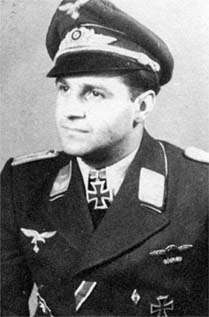Franz Schall
| Franz Schall | |
|---|---|
 Franz Schall | |
| Born |
1 June 1918 Graz, Austria |
| Died |
10 April 1945 (aged 26) Parchim |
| Allegiance |
|
| Service/branch |
|
| Rank | Hauptmann |
| Unit | JG 52, Kommando Nowotny, JG 7 |
| Battles/wars | |
| Awards | Knight's Cross of the Iron Cross |
Franz Schall (born 1 June 1918 – 10 April 1945) was a German pilot in the Luftwaffe during World War II. He was a recipient of the Knight's Cross of the Iron Cross of Nazi Germany; for the fighter pilots, it was a quantifiable measure of skill and combat success.
Career
In August 1944, Schall was appointed the Staffelkapitän (squadron leader) of 3./52. Now fighting across southern Poland and based out of Krakow, it led to his most prolific period in the war with a number of multiple victories in a day: three on 12 August (74-76), three more on the 24th (79-81), 11 on the 26th (83-93) including six Il-2s and 13 on 31 August to bring him up to his century (97-109) including eleven Il-2s. He was the 81st Luftwaffe pilot to achieve the century mark.[1]
On 8 November 1944, Fighter General Adolf Galland was visiting to question the slow progress with the unit. But only four aircraft were able to take to the air. Although Schall could not get through to the bomber stream, he was able to shoot down a pair of United States Army Air Forces (USAAF) P-51 Mustang fighter escorts, but then suffered a flameout of both engines. While attempting to glide back to his base at Hesepe, he was intercepted by a P-51, probably piloted by 1st Lt. James W. Kenney of the 357th Fighter Group, which badly damaged Schall's Me 262 A-1a. Schall managed to bail out just before his aircraft exploded. It was far worse though for the unit Kommodore Maj Nowotny who was, in almost identical circumstances, also pounced by Mustangs after another engine flameout. Witnesses saw his burning aircraft plummet straight into the ground just east of their Hesepe airfield, killing Nowotny instantly.[2][3]
Within a fortnight the unit had been disbanded, and absorbed into the newly formed JG 7, the world’s first operational jet-fighter unit, and Schall, now with 122 victories, and his unit (now renamed 10./JG 7) was based at Oranienburg. He continued to score regularly in the Me 262, eventually ending with at least 14 confirmed jet victories (there were probably more victories, but they remain unconfirmed amidst the chaotic records of the last days of the war), making him the 3rd highest scorer of jet victories in the war. On 22 March 1945, he shot down a Yak-9, probably the one flown by L.I. Sivko from 812.IAP, himself one of the first Soviet pilots to shoot down an Me 262 jet fighter.[4] Schall was credited with 137 [5] victories in 550 missions.[6]
Awards
- Ehrenpokal der Luftwaffe 22 February 1944,[7]
- German Cross in Gold on 20 March 1944 as Leutnant in the I./JG 52,[8] or 5 June 1944
- Knight's Cross of the Iron Cross on 10 October 1944 as Leutnant and Staffelführer of the 3./JG 52[9]
- Mentioned in the Wehrmachtbericht on 1 September 1944
References
Citations
Bibliography
- Forsyth, Robert (2008). Aviation Elite Units #29: Jagdgeschwader 7 'Nowotny’. Oxford: Osprey Publishing Limited. ISBN 1-84603-320-9
- Morgan, Hugh. Gli assi Sovietici della Seconda guerra mondiale. (in Italian) Edizioni del Prado/Osprey Aviation, 1999. ISBN 84-8372-203-8.
- Morgan, Hugh & Weal, John (1998). German Jet Aces of World War 2. Oxford: Osprey Publishing Limited. ISBN 1-85532-634-5, with colour aircraft profiles #4 & #18
- Obermaier, Ernst (1989). Die Ritterkreuzträger der Luftwaffe Jagdflieger 1939 – 1945 [The Knight's Cross Bearers of the Luftwaffe Fighter Force 1939 – 1945] (in German). Mainz, Germany: Verlag Dieter Hoffmann. ISBN 978-3-87341-065-7.
- Patzwall, Klaus D.; Scherzer, Veit (2001). Das Deutsche Kreuz 1941 – 1945 Geschichte und Inhaber Band II [The German Cross 1941 – 1945 History and Recipients Volume 2] (in German). Norderstedt, Germany: Verlag Klaus D. Patzwall. ISBN 978-3-931533-45-8.
- Scherzer, Veit (2007). Die Ritterkreuzträger 1939–1945 Die Inhaber des Ritterkreuzes des Eisernen Kreuzes 1939 von Heer, Luftwaffe, Kriegsmarine, Waffen-SS, Volkssturm sowie mit Deutschland verbündeter Streitkräfte nach den Unterlagen des Bundesarchives [The Knight's Cross Bearers 1939–1945 The Holders of the Knight's Cross of the Iron Cross 1939 by Army, Air Force, Navy, Waffen-SS, Volkssturm and Allied Forces with Germany According to the Documents of the Federal Archives] (in German). Jena, Germany: Scherzers Militaer-Verlag. ISBN 978-3-938845-17-2.
- Spick, Mike (1996). Luftwaffe Fighter Aces. Ivy Books. ISBN 0-8041-1696-2.
- Weal, John (2001). Bf 109 Aces of the Russian Front. Oxford, UK: Osprey Publishing. ISBN 978-1-84176-084-1.
- Weal, John (2004). Jagdgeschwader 52: The Experten (Aviation Elite Units). Oxford, UK: Osprey Publishing. ISBN 978-1-84176-786-4.
- Die Wehrmachtberichte 1939–1945 Band 3, 1. Januar 1944 bis 9. Mai 1945 [The Wehrmacht Reports 1939–1945 Volume 3, 1 January 1944 to 9 May 1945] (in German). München, Germany: Deutscher Taschenbuch Verlag GmbH & Co. KG. 1985. ISBN 978-3-423-05944-2.